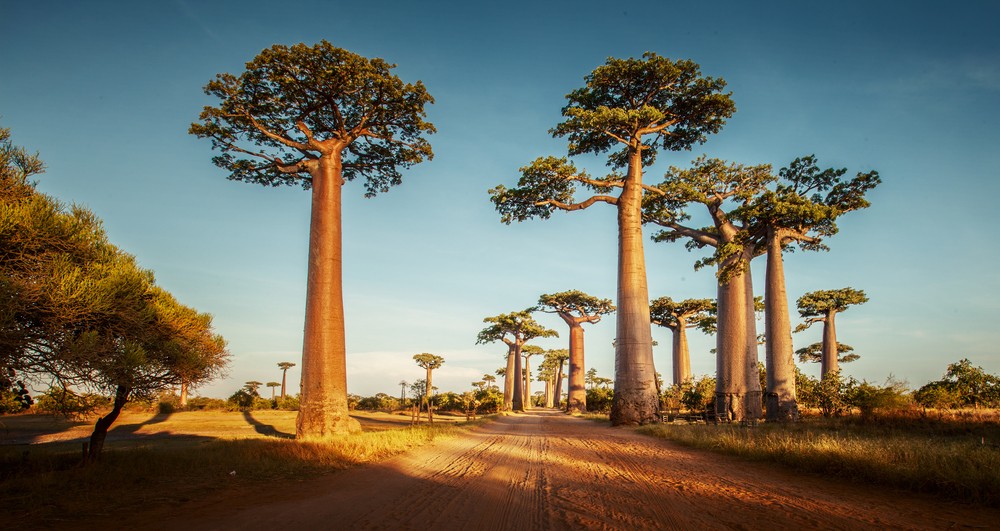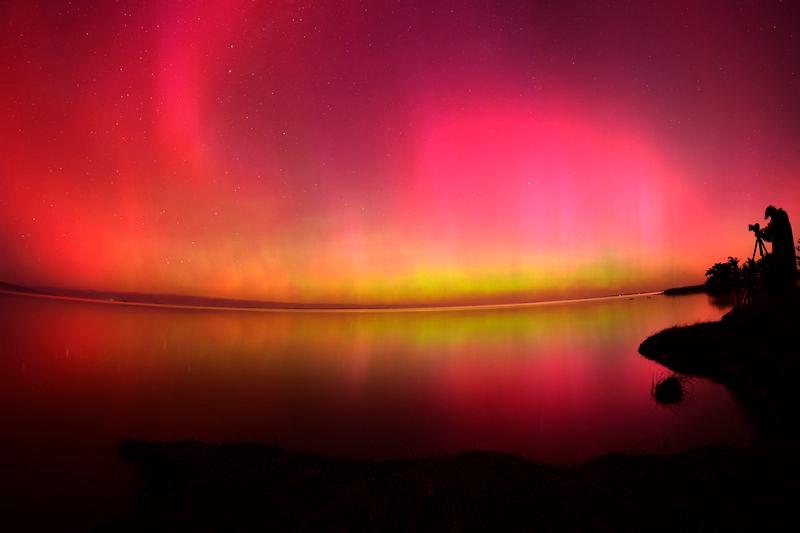뉴스&스피킹(영자신문)
하루 10분이면 영어에 대한 두려움을 극복하고 누구나 유창하게 영어를 구사하실 수 있습니다.
-
 Study Reveals History, Travels of Baobab Tree The baobab tree is a special thing to see. During the dry season, its leafless branches look like roots coming from a thick trunk. It appears as if someone took a tree from the ground, flipped it on its head and put it back into the earth.
Study Reveals History, Travels of Baobab Tree The baobab tree is a special thing to see. During the dry season, its leafless branches look like roots coming from a thick trunk. It appears as if someone took a tree from the ground, flipped it on its head and put it back into the earth.
That is why the tree is sometimes called the "upside down tree."
Baobab trees grow in Madagascar, mainland Africa and Australia. The origins and history of the baobab have been something of a mystery. But a new study that looked at all eight recognized species helps tell the baobab's story.
The baobab originated in Madagascar about 21 million years ago. It reached the African continent and Australia sometime in the past 12 million years, researchers found. Madagascar, an island off Africa's southeastern coast, has a large ecosystem. It is home to many kinds of plants.
Two baobab lineages went extinct in Madagascar. But the lineages established themselves elsewhere, one in mainland Africa and one in Australia, the study showed.
It appears that baobab seed pods floated from Madagascar to mainland Africa, located about 400 kilometers to the west. The seeds also traveled to Australia, nearly 7,000 kilometers to the east.
"The plants almost certainly got to Africa and Australia floating on or with vegetation rafts," said plant expert Tao Wan of the Wuhan Botanical Garden in China. He is one of the writers of the study, which appeared recently in the publication Nature.
Wan added that the seeds were able to travel to Australia because of the Indian Ocean gyre, an oceanic current.
Baobab trees provide food, shelter and nesting places for wildlife, including bees, birds and various mammals. Their fruits also provide important nutrients and medicines for people. Baobab leaves can be eaten, too.
The trees produce large, sweet-smelling flowers. Their sugary nectar appeals to nighttime pollinators like fruit bats and hawk moths. Their flowers also attract two kinds of primates -- lemurs in Madagascar and bush babies in Africa.
Ilia Leitch is a plant geneticist at the Royal Botanic Gardens Kew in London. He is also a study co-writer. He said baobabs can grow to be very large and live for thousands of years.
Their very large root systems “play an important ecological role, helping to slow down soil erosion and enabling nutrient recycling,” he said.
Baobabs are a water source for local people during the dry season. But Africa's baobabs are at risk from elephant damage. The animals sometimes cut the tree trunks with their tusks to get water.
I’m Dan Novak.View -
 Many Handy 'Hand' Expressions And now, Words and Their Stories, from VOA Learning English.
Many Handy 'Hand' Expressions And now, Words and Their Stories, from VOA Learning English.
Every day, we do countless things with our hands. So, it’s not surprising that we have many “hand” expressions that describe how we do something. These hand expressions could be called handy … meaning they are useful.
When we do something with our bare hands, we do it on our own, usually with much effort. When we use this expression, we are expressing pride in something we have done.
For example, let’s say I decided to build my own gardening shed -- a small outdoor building for gardening supplies. It was hard work and took me days to finish. But at the end of the project, I could proudly say that I built it with my own bare hands.
Feeling proud and finishing a big project go hand in hand. They go together!
Firm hand = strict
Let’s say you are asked to lead a project. You want it to be successful. You want it to be on time and on budget. So, you lead with a firm hand. If you lead with a firm hand, you are strict. You follow all the rules closely. You don’t let jokes or laziness affect your team’s progress. Teachers can teach with a firm hand. And parents can parent with a firm hand, too. Having a firm hand and being strict go hand in hand.
Heavy hand = oppressive
A firm hand is not the same as a heavy hand. If a person or organization has a heavy hand, they use a lot of force or power to control people and events. A heavy hand is often considered a bad thing. When you deal with a situation with a heavy hand, you could be seen as oppressive. Someone who is heavy-handed is severe or harsh when dealing with others or when dealing with a situation.
Sometimes we call this an iron hand or even an iron fist. A fist is a closed hand that is used for hitting.
High-handed = arrogant & condescending
Now, what kind of person has a high hand? Someone who has a high hand is domineering. They like to be in control. They are bossy.
Sometimes we use the adjective high-handed.
High-handed people do not consider the rights, concerns, thoughts, or feelings of others. They look down on people. In other words, they are arrogant and condescending.
Hand expressions can also describe our involvement in a situation. Let’s look at a couple examples.
A friend of yours asks you to find a manager for her company. But you don’t know anyone who fits the job description. So, you don’t suggest anyone. You don’t have a hand in the selection. If you have a hand in something, you have helped to make it happen.
Your friend was able to find someone for the job through another person – someone you know. Let’s call him Bob. You know Bob, and you don’t trust Bob. So, you warn your friend. But they don’t take the warning seriously. In the end, Bob is a terrible choice. He steals a lot of money from your friend’s company. Your friend is furious! And you feel bad.
Clean hands = innocent
But in this matter, your hands are clean. You did nothing wrong. In fact, you tried to warn your friend. We use this expression to state innocence in a bad situation.
Here’s another example. Let’s say you are babysitting some children. They want to make a cake. And they make a total mess in the kitchen. Flour, sugar, and broken eggs are everywhere. When their parents come home and see the mess, you can say you did not have a hand in it. The kids did it all. All you did was turn on the oven.
Maybe these kids do this every time you watch them. You are tired of it – even though they do make tasty cake. So, you throw your hands up! When you throw your hands up, you are tired of fighting something. It is a sign that you give up.
A good word that describes this feeling is exasperation. People who are exasperated are tired of something, and they often throw their hands in the air.
And that’s the end of this Words and Their Stories. Until next time, I’m Anna Matteo.
Anna Matteo wrote this lesson for VOA Learning English.View -
 New Food Flavors Coming to Stores In New York, Van Leeuwen Ice Cream brings people in with classic flavors like vanilla and pistachio. But, sometimes, the ice cream maker adds what it calls a “shock flavor,” like Hidden Valley Ranch or pizza, to the treat.
New Food Flavors Coming to Stores In New York, Van Leeuwen Ice Cream brings people in with classic flavors like vanilla and pistachio. But, sometimes, the ice cream maker adds what it calls a “shock flavor,” like Hidden Valley Ranch or pizza, to the treat.
Recently, chocolate maker Hershey added pink lemonade, a summer drink flavor, to its candy Kit Kats. And Frito-Lay introduced potato chips that taste like strawberries with a little bit of bacon.
Not to be outdone, Britain’s food company Little Moons produced fish-and-chip mochi ice cream flavor while Walkers celebrated the holidays with a potato chip flavor of Brussels sprouts.
Usually, these flavor combinations are introduced for a limited time. But sometimes the flavors are so popular that they become permanent additions. That is what happened with Frito-Lay’s Flamin’ Hot Dill Pickle chips in 2019.
While it would be easy to say the new and surprising flavors are produced to get attention on social media, experts say there is more to the story.
They say food companies are reacting to people’s changing and expanding tastes while also trying to stay current and win over space in stores.
Kristen Braun works for Chicago-based food and drink company Mondelez International. She says people now want more than just one flavor and “companies are finding the freedom to explore a little bit more and get more creative.”
Mondelez plans to release Sour Patch Kids Oreos – a kind of sweet vanilla cream-filled cookies combined with sour candies. The flavor is one of more than ten different Oreo flavors being sold this year for a limited time of nine weeks.
Mark Lang teaches food marketing at the University of Tampa in Florida. He said that manufacturers and their suppliers have increased their ability to create such products. That has made it easier for them to experiment and put out limited editions more often.
Kyle Shadix is a research chef for the drink company PepsiCo. He said members of Generation Z, born between 1997 and 2012, are also fueling new ideas.
Shadix is currently experimenting with Mexican, Korean and Japanese flavors. “Gen Z is going to drive us faster. We’re going to start to see even more exploration quicker than in the past because they’re just so open to it.”
Experimenting with new flavors can increase sales in several ways. Sometimes they bring in new buyers to a product. And sometimes they also influence buyers to pick up more of the original flavor.
Russell Zwanka is director of the food marketing program at Western Michigan University. He said, “Sour Patch Oreos sound interesting, but nobody wants to risk buying Oreos that don’t taste good, so people buy both.”
When companies combine products, they are trying to build a link in people’s minds. For example, Lang said when Pepsi combined its drink with Peeps candy flavor, it sent a message that Pepsi is current and fun.
But new flavor combinations do not always work.
Ben Van Leeuwen, the founder of the ice cream company bearing his name, said he could not eat more than a few bites of his company’s Hidden Valley Ranch ice cream. It contained onion and garlic powders. And the “shock flavor” did not become a permanent part of his company’s offerings because of their lower “eat-ability,” he said.
But Lang thinks the more time people spend in restaurants or trying out new foods, the more they seek out unusual flavors.
He said as humans, “We like to experiment.”
I’m Gregory Stachel.View -
 When Does Air Turbulence Become Dangerous? If you have flown on an airplane before, you might have experienced turbulence. Turbulence is a sudden movement of air. It can move the plane around and force sudden changes in height.
When Does Air Turbulence Become Dangerous? If you have flown on an airplane before, you might have experienced turbulence. Turbulence is a sudden movement of air. It can move the plane around and force sudden changes in height.
Flying through mild turbulence feels like driving a car over big bumps or holes in the road.
But passengers on a Singapore Airlines flight on Tuesday experienced severe turbulence. Several people were injured and one person, a 73-year-old British man, died. The exact cause of the man’s death is still unclear.
While turbulence-related deaths are rare, injuries have increased over the years. Some weather and aviation experts have noted increasing reports of turbulence. They say climate change may be behind the increase.
What is turbulence?
Turbulence is unstable air that moves unpredictably. Most people link it with heavy storms. But the most dangerous kind is clear-air turbulence. This often happens with no warning signs in the sky ahead.
Clear-air turbulence happens most often in or near rivers of air called jet streams. The cause is something called wind shear. That is when two huge air masses near each other move at different speeds. If the difference in speed is big enough, it breaks into circular movements.
Thomas Guinn is an aviation science expert at the Embry-Riddle Aeronautical University in Daytona Beach, Florida. He said, “When you get strong wind shear near the jet stream, it can cause the air to overflow. And that creates these chaotic motions in the air.”
How common are turbulent-related injuries?
The U.S. National Transportation Safety Board (NTSB) reported that more than one-third of all airline incidents in the U.S. from 2009 to 2018 were related to turbulence. Most of them resulted in one or more serious injuries to passengers, but no damage to the plane.
Between 2009 and 2022, the NTSB said 163 people were injured seriously enough during turbulence events to require hospital treatment for at least two days. Most of those injured were flight attendants. They are especially at risk because they are more likely to be out of their seats during a flight.
Singapore Airlines said its plane dropped about 1,800 meters in about three minutes last Tuesday, after hitting severe turbulence over the Indian Ocean. In addition to the one death, six or seven passengers were severely injured. Several others suffered less serious injuries.
Larry Cornman is a scientist at the U.S. National Center for Atmospheric Research. He has studied turbulence for many years. He said, “It’s not uncommon to have turbulence encounters that cause minor injuries up to, say, a broken bone,… But fatalities are very, very rare — especially for large transport aircraft.”
Stuart Fox is with the International Air Transport Association. He said, until Tuesday, it had been 27 years since a passenger died following clear-air turbulence on a major airline.
Can pilots avoid turbulence?
Pilots use several methods to avoid turbulence, including using weather radar images. Sometimes they can simply see and fly around the storms.
But clear-air turbulence can happen unexpectedly.
Doug Moss is a former airline pilot and safety expert. He said air traffic controllers will warn pilots after another plane runs into clear-air turbulence. Many pilots also look at the upper-level jet streams along their flight path for signs of wind shear. They can plan to move above, below, or around those areas, he added.
Does climate change lead to more turbulence?
Some scientists note that reports of turbulence encounters are on the rise. There are several possible explanations for that. But several researchers have pointed to climate change.
Guinn, of Embry-Riddle Aeronautical University, explained that some experts predict climate change could change the jet stream and increase the wind shear. This would drive up turbulence in the air.
Paul Williams is a professor of atmospheric science at Britain’s University of Reading. In a statement Tuesday, he said there was “strong evidence that turbulence is increasing because of climate change.”
Williams said his research team recently discovered that severe clear-air turbulence in the North Atlantic has increased by 55 percent since 1979. The team estimated that severe turbulence in the jet streams could double or triple in the coming years under current conditions.
Other experts note that an increase in air travel could be the reason for the increase in turbulence encounters.
How can travelers stay safe?
Turbulence can be hard to predict. But experts note that the first line of defense in the air is keeping seat belts fastened whenever possible.
“Wear your seat belt,” Guinn said. “That’s just a really quick fix to prevent injury.”
I'm John Russell.
And I'm Ashley Thompson.View -
 Severe Solar Storm Hits Earth, Causing Colorful Light Shows Earth was recently hit by the most powerful solar storm in more than 20 years.
Severe Solar Storm Hits Earth, Causing Colorful Light Shows Earth was recently hit by the most powerful solar storm in more than 20 years.
The storm caused some colorful light shows in some parts of the world, but no major damage was reported. Solar storms can hurt the operation of some equipment on Earth that uses radio waves. This includes GPS services, electrical systems and satellites.
The U.S. National Oceanic and Atmospheric Administration (NOAA) issued warnings about the storm before it reached Earth on May 10. In a statement, NOAA said it had observed heavy solar storm activity in the days before. Based on the activity, the agency issued a Geomagnetic Storm Warning.
Solar storms can involve two different processes. One is called a solar flare, while the other is a coronal mass ejection (CME). Both involve huge releases from the sun of magnetic field energy and a substance called plasma. The American space agency NASA explains that plasma is a form of matter made up of ionized particles. This means the particles have taken in so much energy that it causes electrons to separate from their atoms.
Solar flares travel at the speed of light in all directions. They can reach Earth in about eight minutes. But CMEs travel much slower. They reach Earth in one to three days. NOAA said a strong “solar flare event” had led to the latest CMEs hitting Earth.
NASA says its observatories see solar flares as flashes of light on the sun, while CMEs are seen as large explosions spreading out into space. The agency examines data from its Parker Solar Probe on plasma flowing out of the sun’s corona.
Because the latest CME explosions were directed at Earth, they caused geomagnetic storms. NOAA’s Space Weather Prediction Center issued a warning, calling the storm activity “an unusual and potentially historic event.”
NOAA noted that such storms can cause problems for some communication systems. The agency informed major power operators and NASA officials about the storm activity. The electric power grid can also be affected, or disrupted, along with radio, satellite and spacecraft operations.
NOAA noted that severe geomagnetic storms can also produce intense, colorful light shows, or displays, in the sky. Such shows are also known as auroras.
Colorful displays could be seen overnight in different parts of the world. Reuters news agency reported on several areas in Latin America experiencing auroras after the solar storm activity. In Mexico’s desert city of Mexicali, pink and purple light could be seen lighting up the night sky last Friday and Saturday.
In Chile, Reuters reported local media and social media users shared photos of the sky in the city of Punta Arenas, where the lights took on red and purple tones. Local media in Argentina also reported similar displays in the Patagonian city of Ushuaia.
The French news agency AFP reported social media services were filled up with people publishing images of auroras from areas including northern Europe and Australasia.
Iain Mansfield lives in Hertford, Britain. He told AFP, "We've just woken the kids to go watch the Northern Lights in the back garden! Clearly visible with the naked eye."
Other people also compared the intense color shows to the Northern Lights. Sometimes also called aurora borealis, the Northern Lights are natural, colored light displays that sometimes appear in the night sky in the most northern parts of the world.
From Australia’s island state of Tasmania, photographer Sean O’ Riordan published a message on X explaining what he saw. "Absolutely biblical skies in Tasmania at 4am this morning. I'm leaving today and knew I could not pass up this opportunity."
People in the United States were also able to see colorful auroras, including parts of the West Coast and as far south as Alabama.
The most intense solar storm in recorded history happened in 1859. It mainly produced auroras in Central America. A severe geomagnetic storm in 2003 cut power in Sweden and damaged power transformers in South Africa.
Storm activity coming from the sun generally intensifies as it reaches the height of a repeating, 11-year solar cycle. The activity increases as the sun experiences magnetic field changes that affect its polar areas
I’m Bryan LynnView

